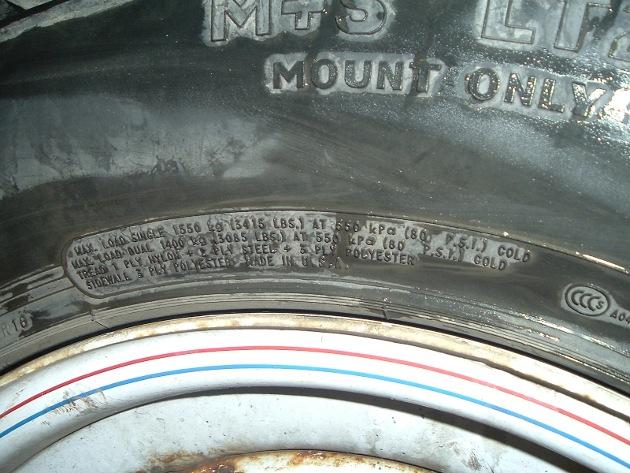Tire Inflation Pressure Formula
Gather Information of the Truck and Tires
You going to need some information about the truck and the tires to use this formula. You need to scale the truck as you plan on using it this means with full load of cargo, trailers, full tank of fuel, etc. You need the front and rear axle weights. Then your going to need the information about the tire and its ablities for weight which are typically on the side wall.
Here is the 265/75 R16's I'm running right now.
The Formula
Rather pretty simple formula once you see you'll understand how it works.
Single Tire: (Axle Weight / 2) / Tire Capacity weight x Tire Max Pressure = Inflation Pressure
Dual Rear Tires: (Axle Weight / 2) / (Tire Capacity weight x 2) x Tire Max Pressure = Inflation Pressure
So we'll now start to plug in information provided from the scale and the tire. I'll start with the front axle. The first part of the calculation is dividing the axle weight in half to give the weight placed on each tire of the front axle.
(4,440 Pounds / 2) = 2,220 Pounds
Now we'll take the half weight and divide it over the the weight capacity of the tire. This should result in a decimal answer or a percentage of weight capacity that has been used.
2,220 Pounds / 3,415 Pounds = 0.65 (65% Percent)
WARNING: You should never see a answer above 1.00. You are over weight for the tires and/or vehicle.
Now we multiply the percent number against the maximum inflation pressure of the tire to get the inflation pressure for your current weight.
0.65 x 80 PSI = 52 PSI
Front Tire Inflation
So we get out our handy tire pressure gauge and adjust the front axle pressure to match.
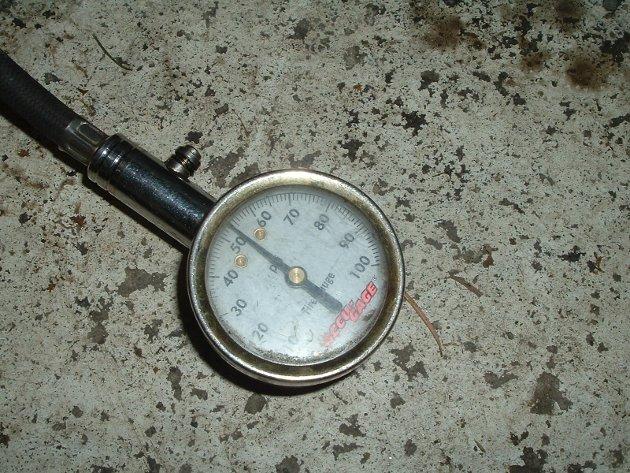
The Results Of The Front Inflation Pressure
What you get is a tire that sits completely flat on the tread face and should have a very slight belly to it when look across the profile. Now you might have to adjust pressure a bit to suit your tats but typically you shouldn't need much more than +/- 5 PSI to make it right.
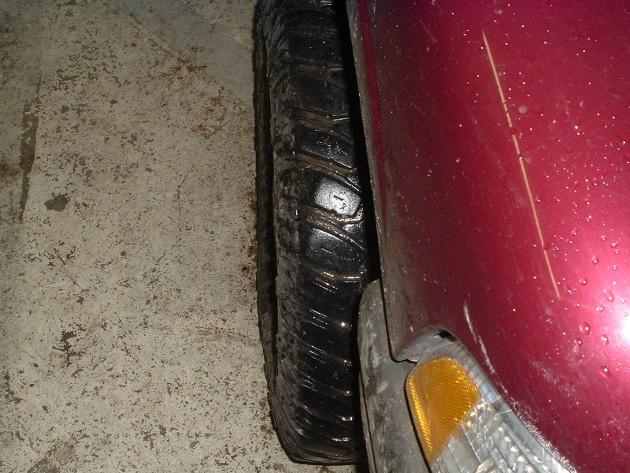
Rear Tire Inflation
This is where most people get panicy of the result they get from the formula. The rear axle weight on most of these truck is rather light. Like my truck in typical empty condition weighs out at 2,860 pounds so lets calculate that out quickly.
( 2,860 / 2) / 3,415 X 80 = 33 PSI
So here is my current pressure and tire profile.
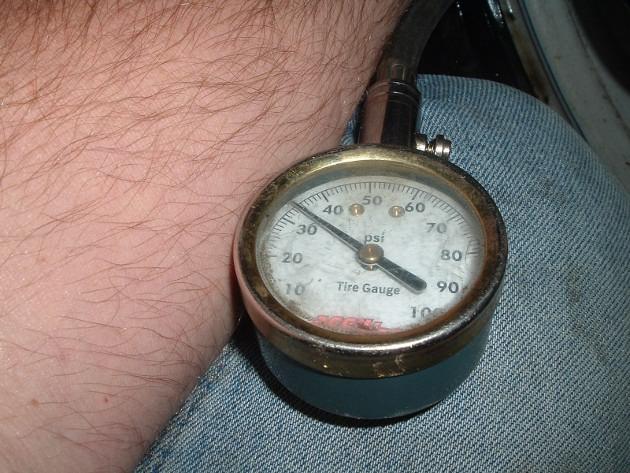
Yes this is correct pressure vs. weight. It seems low but that because there is no weight on the rear axle. Now if I was to hitch up the RV trailer and readjust pressure vs. weight the mat would be different. With my RV I'm 4,280 pounds on the rear axle.
(4,280 / 2) / 3,415 x 80 = 50 PSI
Another Example with Load Range G's
I've got a set of Load Range G's tires I use during the summer that have unusual specs. But I'll run the math to show no matter what you use for a tire you can figure out the pressures.
Tires: Solid Trac (By Voma) 235/85 R16 - 3,750# @ 110 PSI
Front Axle: (4,440 / 2) / 3,750 x 110 = 65 PSI
Rear Axle (2,860 / 2) / 3,750 x 110 = 42 PSI
Pressures vs. MPG's
So far all the time I've used my formula I've never had any problems with MPG's from a result of low pressures. I used the calculated pressure and then increased it 10 PSI over calculated to see if there is any gains in MPG's. What I found is no gains where to be had in overflation. But your ride will suffer and tire wear will occur more so in the center of the tire. Like all my tire wear are even across the face and fairly even remaining tire tread on the outside of the tread vs. centers. All I can say it try it for yourself.
Verification Of Pressure To Brand Name Tables
Here is a Michelin Web Site page for Tire Pressures.
http://www.michelinrvtires.com/michelinrv/tires-retreads/load-inflation-tables.jsp
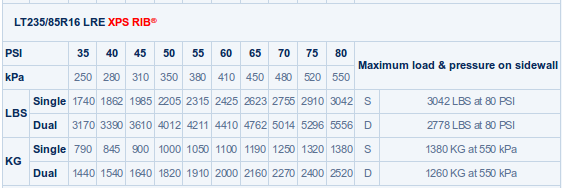
Show a demo of Formula vs. Table pressures from Michelin.
Axle Weight: 4,850# on Single Tire Axle
Single Tire Forumla: (Axle Weight / 2) / Tire Capacity weight x Tire Max Pressure = Inflation Pressure
(4,850# / 2) = 2,425# / 3,042# = 0.79 x 80 PSI = 63.7 PSI
Axle Weight: 8,820# On Duals Rear Axle
Dual Rear Tires Formula: (Axle Weight / 2) / (Tire Capacity weight x 2) x Tire Max Pressure = Inflation Pressure
(8,820 / 2) = 4,410# / (2778# x 2 = 5,556#) = 0.79 x 80 = 63.4 PSI
Take note on duals tire axles you got to double the 2,778# rating of the tire and then divide your axle weight. But with both sets the pressure number is right there within 3 PSI of the tire pressure chart of Michelin.
Disadvantages of Underinflation
An underinflated tire can't maintain its shape and becomes flatter than intended while in contact with the road. Additionally, the tire's tread life could be reduced by as much as 25%. Lower inflation pressure will allow the tire to deflect (bend) more as it rolls. This will build up internal heat, increase rolling resistance and cause a reduction in fuel economy of up to 5%. You would experience a significant loss of steering precision and cornering stability.
Properly Inflated
This is the balance between under inflation and over inflation. You still maintain some flexibility to the tire which will keep the comfort to the ride without creating excessive flexing, heat generation or sacrificing MPG numbers. As you'll see both underinflation and overinflation will cause issues with handling and tire wear / damage.
Disadvantages of Overinflation
An overinflated tire is stiff and unyielding and the size of its footprint in contact with the road is reduced. They could be damaged more easily when running over potholes or debris in the road. Higher inflated tires cannot isolate road irregularities well, causing them to ride harsher. However, higher inflation pressures usually provide an improvement in steering response and cornering stability up to a point. This is why participants who use street tires in autocrosses, track events and road races run higher than normal inflation pressures. The pressure must be checked with a quality air gauge as the inflation pressure cannot be accurately estimated through visual inspection.
Chrysler OEM Specified Tire Pressures
This is stated for 265/75 R16 tires for 2002 Dodge Ram 2500 4WD 5.9L Diesel.
Light Load
Fornt 40 PSI and Rear at 40 PSI.
For weights up to GAWR
Front 65 PSI and Rear 80 PSI.
As specified on the door. Now also be aware that no vehicle should be capable of reaching GAWR safely. As you can see my GVWR is 8,800 pounds. Knowning my front axle weighs out at 4,440 pounds this means the maximum rear axle weight will be 4,360 pounds which would add up to 8,800 pounds GVWR. So in my case maximum actual pressure would be 57 PSI for both front and rear at GVWR. So there is no reason to inflate the tires above 60 PSI ever in my case because I would exceed the GVWR anyways. Just adding the two GAWR number comes out at 11,284 pounds which is 2,484 pounds over weight which happens to be 1.2 tons over!
As you'll see my formula takes into account the actual axle weights also the changes of tire capacity from brand to brand. Were the OEM document only specifies the tire pressure for the factor brand tire (Michelin LTX 265/75 R16). Like myself I've change wheels and tire size. Just changing brand name you have to re-calculate your pressures. I've now owned tires with weight ratings from 3,042 to 3,750 pounds at a range of pressures from 80 PSI to 110 PSI. So the factory specified pressures no longer work and you need to figure out your base line pressure. So don't let the factory number lead you to blow outs.
Tire Pressure profile photos
Another view of tire pressure in photos. This is my rear tire of my truck. Now the tire at this time is a Black Lion HT 235/85 R16 (3,086 pounds @ 80 PSI). Calculated I should have 37.07 PSI in the tire but I'm going to start from dead flat and step up 5 PSI and shoot pictures of the tire. The camera is on a tripod and not going to be moved. Take notice at calculated pressure the tire had a very mild belly at calculated pressure as radial tires are designed to have but the next picture the belly is gone and the tire does not change much after that calculated point. The only thing it does do is roughen the ride and ride more so on the center of the tire tread reducing traction.
2,860 / 2 = 1,430 / 3,086 = 0.46 x 80 = 37.07 PSI




